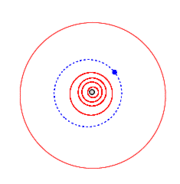9951 Tyrannosaurus
9951 Tyrannosaurus, provisional designation 1990 VK5, is a stony Vestian asteroid from the inner regions of the asteroid belt, approximately 17 kilometers in diameter. It was discovered on 15 November 1990, by Belgian astronomer Eric Elst at ESO's La Silla Observatory in northern Chile.[7] It was named after Tyrannosaurus, a genus of dinosaurs.[3]
 Orbit of Tyrannosaurus (blue), with the inner planets and Jupiter (outermost) | |
| Discovery [1] | |
|---|---|
| Discovered by | E. W. Elst |
| Discovery site | La Silla Obs. |
| Discovery date | 15 November 1990 |
| Designations | |
| (9951) Tyrannosaurus | |
| Pronunciation | /tɪˌrænəˈsɔːrəs/[2] |
Named after | Tyrannosaurus (theropod dinosaur)[3] |
| 1990 VK5 · 1974 OG1 1992 EZ5 | |
| main-belt · (inner) Vesta [4] | |
| Orbital characteristics [1] | |
| Epoch 4 September 2017 (JD 2458000.5) | |
| Uncertainty parameter 0 | |
| Observation arc | 42.53 yr (15,534 days) |
| Aphelion | 2.7243 AU |
| Perihelion | 2.1283 AU |
| 2.4263 AU | |
| Eccentricity | 0.1228 |
| 3.78 yr (1,380 days) | |
| 155.31° | |
| 0° 15m 38.88s / day | |
| Inclination | 7.4000° |
| 133.42° | |
| 153.36° | |
| Physical characteristics | |
| Dimensions | 17 km[5] |
| S [6] | |
| 14.2[1] | |
Classification and orbit
Based on the Hierarchical Clustering Method, Tyrannosaurus is a member of the Vesta family (401),[4] which is named after its parent 4 Vesta, the main belt's second-largest and second-most-massive body after Ceres.
Tyrannosaurus orbits the Sun in the inner main-belt at a distance of 2.1–2.7 AU once every 3 years and 9 months (1,380 days). Its orbit has an eccentricity of 0.12 and an inclination of 7° with respect to the ecliptic.[1] It was first identified as 1974 OG1 at El Leoncito in 1974, extending the body's observation arc by 16 years prior to its official discovery observation at La Silla.[7]
Physical characteristics
Tyrannosaurus has been characterized as a common S-type asteroid.[6] The overall spectral type for members of the Vesta family is that of a V-type.[8]:23 Vestian asteroids have a composition akin to cumulate eucrites (HED meteorites) and are thought to have originated deep within 4 Vesta's crust, possibly from the Rheasilvia crater, a large impact crater on its southern hemisphere near the South pole, formed as a result of a subcatastrophic collision.[9]
Diameter and albedo
According to the survey carried out by the Infrared Astronomical Satellite IRAS, Tyrannosaurus measures 17 kilometers in diameter.[5] Spectroscopic observations indicate that it is a stony S-type asteroid, the most abundant spectral class of asteroids in the inner main-belt.[6] It has an absolute magnitude of 14.2.[1]
Lightcurves
As of 2017, no rotational lightcurve of Tyrannosaurus has been obtained. The asteroid's rotation period, poles and shape remain unknown.[10]
Naming
This minor planet was named for Tyrannosaurus, a large and heavy bipedal carnivorous dinosaur, that lived in the upper cretaceous. It was one of the most terrifying predators, with a large skull, massive jaws and sharp teeth. Adult individuals were 12 meters long and 4–7 meters high. Tyrannosaurus rex is the best known species of this genus.[3] The official naming citation was published by the Minor Planet Center on 20 November 2002 (M.P.C. 47166).[11]
References
- "JPL Small-Body Database Browser: 9951 Tyrannosaurus (1990 VK5)" (2017-01-28 last obs.). Jet Propulsion Laboratory. Retrieved 22 June 2017.
- "Tyrannosaurus". Oxford English Dictionary (3rd ed.). Oxford University Press. September 2005. (Subscription or UK public library membership required.)
- Schmadel, Lutz D. (2007). "(9951) Tyrannosaurus". Dictionary of Minor Planet Names – (9951) Tyrannosaurus. Springer Berlin Heidelberg. p. 715. doi:10.1007/978-3-540-29925-7_7767. ISBN 978-3-540-00238-3.
- "Asteroid 9951 Tyrannosaurus – Nesvorny HCM Asteroid Families V3.0". Small Bodies Data Ferret. Retrieved 27 October 2019.
- Tedesco E.F.; Noah P.V.; Noah M.; Price S.D. "The supplemental IRAS minor planet survey (SIMPS)".
- Gianluca Masi; Sergio Foglia & Richard P. Binzel. "Search for Unusual Spectroscopic Candidates Among 40313 minor planets from the 3rd Release of the Sloan Digital Sky Survey Moving Object Catalog".
- "9951 Tyrannosaurus (1990 VK5)". Minor Planet Center. Retrieved 9 October 2017.
- Nesvorný, D.; Broz, M.; Carruba, V. (December 2014). Identification and Dynamical Properties of Asteroid Families. Asteroids IV. pp. 297–321. arXiv:1502.01628. Bibcode:2015aste.book..297N. doi:10.2458/azu_uapress_9780816532131-ch016. ISBN 9780816532131.
- Kelley, Michael S.; Vilas, Faith; Gaffey, Michael J.; Abell, Paul A. (September 2003). "Quantified mineralogical evidence for a common origin of 1929 Kollaa with 4 Vesta and the HED meteorites". Icarus. 165 (1): 215–218. Bibcode:2003Icar..165..215K. doi:10.1016/S0019-1035(03)00149-0. Retrieved 9 October 2017.
- "LCDB Data for (9951) Tyrannosaurus". Asteroid Lightcurve Database (LCDB). Retrieved 17 March 2017.
- "MPC/MPO/MPS Archive". Minor Planet Center. Retrieved 17 March 2017.
External links
- Asteroid/Comet News, Columbine, Inc., November 2002
- Asteroid Lightcurve Database (LCDB), query form (info)
- Dictionary of Minor Planet Names, Google books
- Asteroids and comets rotation curves, CdR – Observatoire de Genève, Raoul Behrend
- Discovery Circumstances: Numbered Minor Planets (5001)-(10000) – Minor Planet Center
- 9951 Tyrannosaurus at AstDyS-2, Asteroids—Dynamic Site
- 9951 Tyrannosaurus at the JPL Small-Body Database
